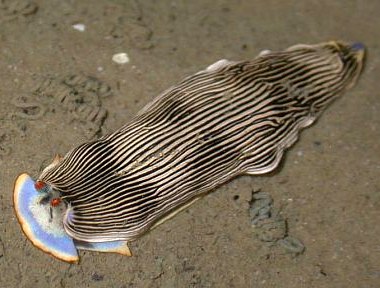
Armina semperi
(Bergh, 1861)
Order: NUDIBRANCHIA
Suborder: ARMININA
Family: Arminidae
PHOTO
intertidal flats, Changi, Singapore. Photo: Ria Tan.
One of a group of species with black and white longitudinal stripes. Identified on Forum, until 5 February 2003, as Armina sp. 2. This species is characterised by a blue foot with a yellow-orange border. See Erwin Koehler's message below.
See also Armina cygnea and Armina sp. 1.
Reference:
• Bergh, L. S. R. 1861. [for 1860]. Om Forekomsten af Neldfiim hos Mollusker. Videnskabelige Meddelelser fra den Naturhistoriske Forening, Kjobenhavn: 309-331, pl. 8.
Rudman, W.B., 2003 (February 2) Armina semperi (Bergh, 1861). [In] Sea Slug Forum. Australian Museum, Sydney. Available from http://www.seaslugforum.net/find/armisemp
Related messages
Re: Armstrong Beach, Queensland. What is it?
March 9, 2010
From: Lawrence Neal
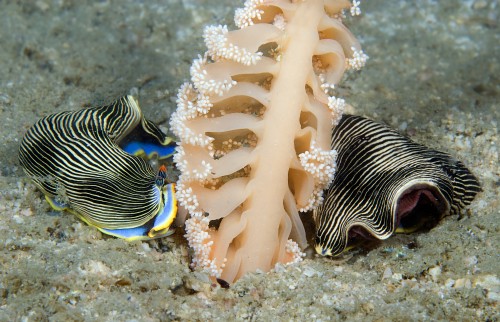
Concerning message #23252:
Dear Sharyn and Bill,
Here are some pictures of sea pens being attacked by Armina semperi in Thailand, which you may find interesting. However, this sea pen is a different species from Sharyn's washed-up individual from Australia - I believe this one is Virgularia sp.
When the Armina nudibranchs approach a sea pen, they raise up off the substrate and stretch up to take a bite quite high up on the Virgularia. As soon as the sea pen senses the attack (after about 1 second) it retracts down into the sand, pulling the nudibranch with it. This can be seen in the photos. In the picture with two individuals, one has already taken a bite and has been dragged down head first into the sediment, while the other one is about to attack the partially retracted sea pen.
This variety of sea pen grows in sandy or silty environments and large specimens get up to about 20 cm tall (above the sand). The Armina semperi can number in the hundreds at certain times and places, perhaps emerging from the sand at times of low current. These pictures were taken in the middle of the day so this species doesn't seem to be nocturnal.
Locality: Koh Phai, Pattaya, 6 metres, Chonburi Province, Thailand, Gulf of Thailand, 14 June 2009, Sandy bay. Length: 50 mm. Photographer: Lawrence Neal.
All the best,
Lawrence
lorenzo_n@yahoo.com
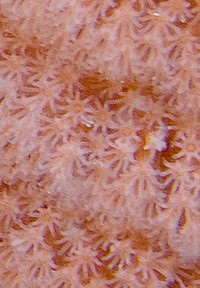
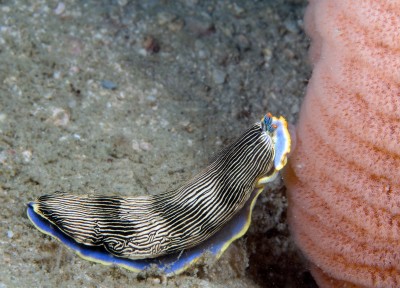
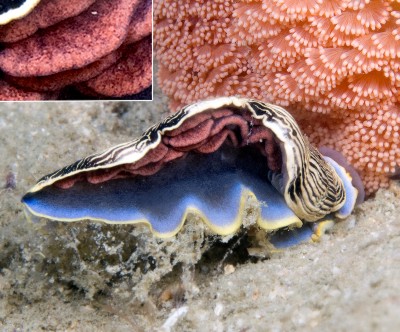
Dear Lawrence,
Thanks for these wonderful photos. This has so much information on Armina semperi that I have linked it with that species Fact Sheet rather than with the Sea Pens. Because of the detailed view of the polyps in your photos, I have added a reference on that page however.
Of particular interest are the pink flaps we can see in your lower photo hidden beneath the mantle skirt. These are often mistakenly considered to be gills, but although gas exchange may be a secondary function, they are like the cerata of aeolids, a place where the digestive gland can expand. They are pink in this animal because that is the colour of their sea pen food.
Best wishes,
Bill Rudman
Armina semperi from Thailand
September 4, 2008
From: Lawrence Neal
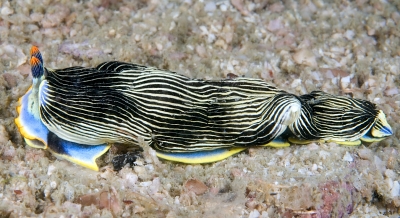
Hi Bill,
Here are a few pictures of an Armina sp. from the Gulf of Thailand. I think it's Armina semperi.
The pictures were taken during the daytime in a sandy, sheltered bay, around 11 metres deep. Several species of sea pen also live in the area.
Locality: Koh Sark, Pattaya, 11 metres, Chonburi, Thailand, Gulf of Thailand, South China Sea, 10 August 2008, Sheltered bay with mixed sand and sediment. Length: 50 mm. Photographer: Lawrence Neal.
Best wishes,
Lawrence
lorenzo_n@yahoo.com
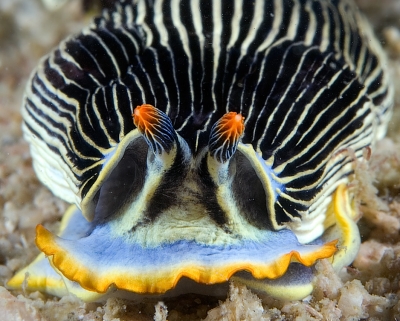
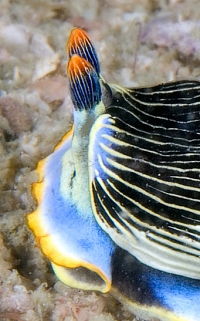
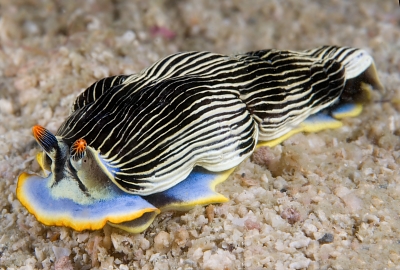
Dear Lawrence,
Thanks for these photos. It is certainly the animal I am calling Armina semperi. I have included a few 'close-ups' to show the detail of the head and rhinophores.
Best wishes,
Bill Rudman
Armina semperi from Changi, Singapore.
February 6, 2003
From: Ria Tan

Dear Bill,
As well as the sea slugs from Chek Jawa, we have also found some other animals on the intertidal flats at Changi, here in Singapore. Anything you can tell us about them would be very interesting.
Best wishes,
Ria Tan
tanria@singnet.com.sg
Tan, R., 2003 (Feb 6) Armina semperi from Changi, Singapore.. [Message in] Sea Slug Forum. Australian Museum, Sydney. Available from http://www.seaslugforum.net/find/9107Dear Ria,
This is a species of Armina but unfortunately there are a group of very similar looking species with longitudinal black lines on their mantle, and yet we know little about them. I suspect this is what I am calling Armina sp. 2 on the Forum. I have decided to follow Baba (1949) in identifying it as Armina semperi (Bergh, 1861). The blue foot with the orange-yellow border seems quite distinctive.
Species of Armina usually eat Sea Pens, but its seems a few will eat other related soft corals.
Best wishes,
Bill Rudman
Armina sp. 2. from Philippines
April 3, 1999
From: Erwin Koehler

Dear Bill,
I found two species of Armina, one with black foot and red-orange border , the other with a pale blue foot and yellow border (see photos here). There were lots of both species at this place, nightdive (my dive no.1000), Philippines, Negros Is., El Dorado housereef, March 1999, 8 - 14m depth.
Erwin
E.Koehler@DeutschePost.de


Dear Erwin,
Thanks for the pics of this species and the other similarly coloured species which I have labelled
Best wishes,
Bill Rudman.
